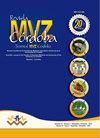苦瓜、红藻和墨旱莲对小刺槐的杀螨效果评价
IF 0.3
4区 农林科学
Q4 AGRICULTURE, DAIRY & ANIMAL SCIENCE
引用次数: 2
摘要
目标。研究了苦瓜(Momordica charantia, Mc)、红衣巨浆虫(Megaskepasma erythrochlamys, Me)和毒舌虫(gliricicidia sepium, Gs)对微型头虱(Rhipicephalus microplus, Rm)的杀螨活性。材料和方法。采用比色法和薄层色谱(CCD)技术对黄芪甲醇提取物(EMc)、黄芪乙醇提取物(EMe)和黄芪丙酮提取物(EGs)的叶片进行了初步的植物化学分析。采用幼虫浸泡试验(LIT)和成虫浸泡试验(AIT)进行体外杀螨活性测定。在现场测试中,使用自然感染蜱虫的放牧牛,使用从体外AIT测试中获得的LC50;随后,将这些尾卵进行孵育,以评估它们的繁殖能力。结果。确定了几组对杀螨感兴趣的次级代谢物的存在。证实了该植物提取物对卵母细胞的杀螨作用;但只有卵磷脂具有杀幼虫活性。160 mg/mL提取物对蛋鸡卵泡发育的抑制率分别为46.9%、66.1%和84.03% (p<0.05)。另一方面,原位试验显示,与对照组相比,EMc和EMe处理之间存在显著差异(p<0.05)。结论。所获得的结果有望加强将这些植物的提取物与控制牛系统中蜱虫的综合计划联系起来的可能性。本文章由计算机程序翻译,如有差异,请以英文原文为准。
Evaluación del efecto acaricida de Momordica charantia, Megaskepasma erythrochlamys y Gliricidia sepium sobre Rhipicephalus microplus
Objective. The acaricidal activity of Momordica charantia (Mc), Megaskepasma erythrochlamys (Me) and Gliricidia sepium (Gs) on Rhipicephalus microplus (Rm) was evaluated. Materials and methods. Preliminary phytochemical analysis of leaves of the methanolic extract of Mc (EMc), the ethanolic extract of Me (EMe) and the acetone extract of Gs (EGs) were carried out through the technique of colorimetry and thin layer chromatography (CCD). The acaricidal activity was performed through in-vitro tests using the larval immersion test (LIT) and the adult immersion test (AIT). For in-situ tests, grazing cattle naturally infested with ticks were used, using the LC50 obtained from the in-vitro AIT tests; later the teleogines were taken to incubation to evaluate their reproductive capacity. Results. The presence of several groups of secondary metabolites of acaricidal interest was determined. The acaricidal effect of the extracts of the plants on teleogines was demonstrated; although only EGs showed larvicidal activity. Extracts at 160 mg/mL affected the life cycle of Rm by inhibiting ovoposition in 46.9%, 66.1% and 84.03% (p<0.05) for EGs, EMc and EMe, respectively. On the other hand, the in-situ tests showed a significant difference (p<0.05) between the treatment of EMc and EMe with respect to the control groups. Conclusions. The results obtained are promising to strengthen the possibility of linking the extracts of these plants into integrated plans for the control of ticks in cattle systems.
求助全文
通过发布文献求助,成功后即可免费获取论文全文。
去求助
来源期刊

Revista Mvz Cordoba
农林科学-奶制品与动物科学
CiteScore
0.70
自引率
0.00%
发文量
41
审稿时长
6-12 weeks
期刊介绍:
The Journal MVZ Córdoba is an open access international scientific journal financed and edited by the University of Córdoba (Colombia). The journal publishes quarterly, continuously in PDF, XML, Epub, original articles, literature reviews, brief communications and clinical cases, peer-reviewed (double-blind) in Spanish and English, which are related to the agricultural and veterinary sciences. The journal is directed to natural and legal persons of veterinary medicine, animal husbandry, public health, epidemiology, aquaculture, biology, basic biomedical sciences and biotechnology and constitutes a space for academic and scientific discussion around the work of professionals in Veterinary Medicine and Zootechnics. Four-monthly publication.
"The Journal MVZ Córdoba supports the policies for registration of clinical trials of the World Health Organization (WHO) and the International Committee of Medical Journal Editors (ICMJE), since it recognizes the importance of these initiatives for international registration and dissemination. of information about clinical studies, in open access. As a result, since 2007, the journal MVZ Córdoba only publishes clinical research articles that have received an identification number in one of the Clinical Trial Registries validated by the criteria established by WHO and ICMJE, whose addresses are available in the ICMJE website. The identification number is recorded at the end of the summary. "
 求助内容:
求助内容: 应助结果提醒方式:
应助结果提醒方式:


